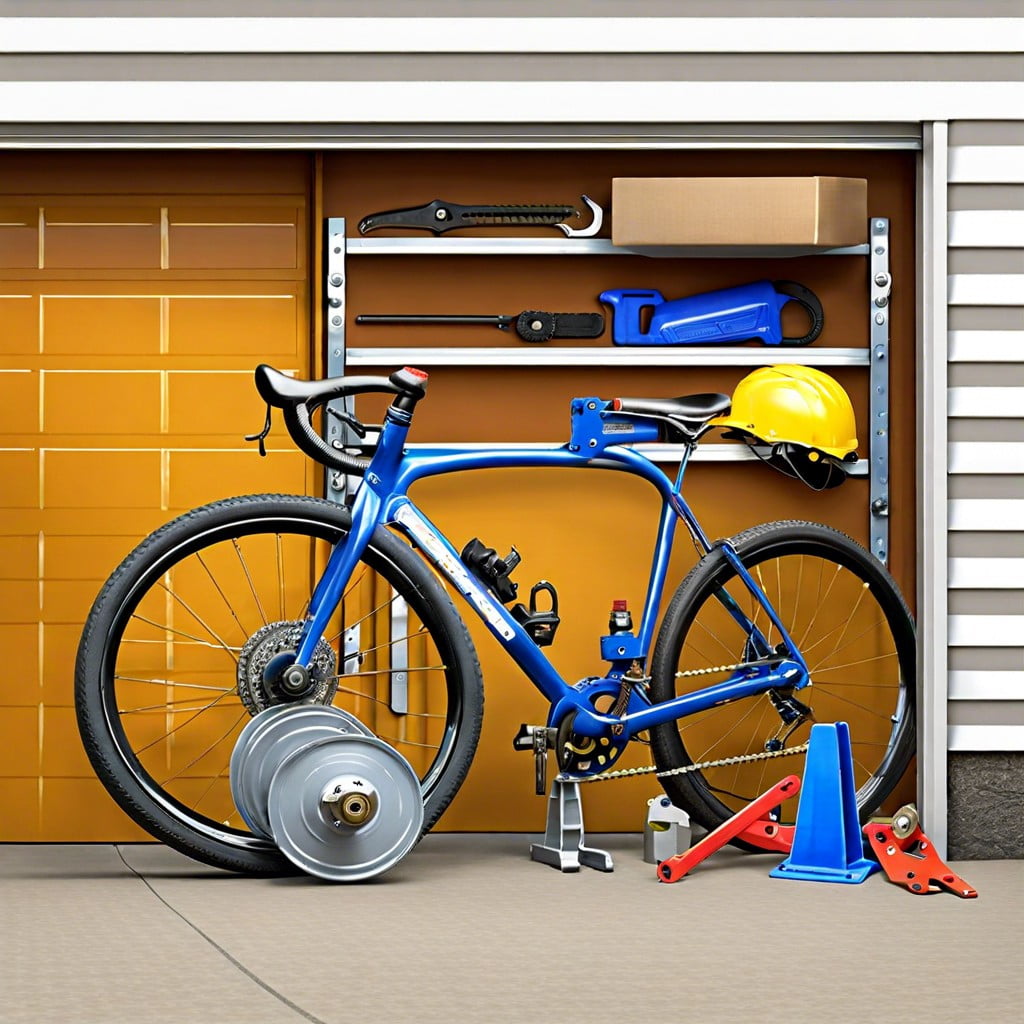Learn how to adjust your garage door yourself with straightforward, practical steps.
Key takeaways:
- Disconnect the garage door opener and wear proper safety gear.
- Have the right tools: ladder, wrenches, locking pliers, and good lighting.
- Ensure balanced tension between garage door cables and springs.
- Adjust torsion springs using winding bars in quarter-turn adjustments.
- Call professionals if the door won’t stay open/close, makes unusual noises, feels heavier, or if issues persist after DIY adjustments.
Safety Precautions for DIY Garage Door Adjustment

Before you start tinkering with your garage door, make sure you’re up to speed on these critical safety measures.
First and foremost, disconnect the garage door opener to prevent it from being activated accidentally while you work. This eliminates the risk of the door moving unexpectedly.
Wear proper safety gear. Sturdy gloves and eye protection are essential to shield you from potential snap-backs from loose components or springs.
Keep children and pets clear of the area. The garage workspace should be off-limits to avoid any unforeseen accidents.
Lastly, consult your garage door’s manual. It will have specifics that align with your model’s requirements and safety warnings. This ensures a procedure that’s not only correct but also safe.
Equipment You’ll Need
Before diving into your garage door adjustment, make sure you have the right tools on hand to ensure a smooth operation. You’ll need a sturdy ladder to reach the mechanism, a set of wrenches to loosen and tighten bolts, and locking pliers. These are essential for holding the components in place while you make adjustments.
Also, consider having a helper. While not absolutely necessary, an extra pair of hands can make the process easier, especially when dealing with heavy or awkward parts. Good lighting is crucial too; you’ll want to see what you’re doing clearly to avoid any mistakes that could lead to injuries or further damage.
Remember, using the correct tools not only facilitates a smoother adjustment process but also helps prevent damage to your garage door system.
Coordinating Garage Door Cables & Springs
Garage door cables and springs work together to smoothly lift and lower your door. They must be synchronized to prevent uneven movement or stress on the system. Here’s a quick explanation of both components and their function:
– **Garage Door Cables**: These are attached to the bottom corners of the door and loop through a pulley system. They help provide the necessary force to lift the door via the torsion or extension springs, depending on your setup.
– **Garage Door Springs**: Torsion springs are usually located above the garage door, while extension springs run along the tracks on each side. Their main job is to store mechanical energy. When you operate the door, these springs unwind to help lift it and tighten to assist in lowering it smoothly.
When adjusting, you’re aiming for balanced tension. If one side is tighter than the other, the door might open unevenly or appear crooked. Adjusting the tension usually involves tweaking the torsion springs and ensuring the cables are taut and not frayed or damaged. Always release the tension in the springs before trying to disconnect or repair cables to avoid injury. Check both sides to make sure they’re evenly adjusted, contributing to a smoother and safer door operation.
Adjusting Spring Tension
Before diving into the tension adjustment, ensure the door is closed and secured. This safety measure prevents the door from suddenly moving while you work.
Start by locating the torsion springs, usually positioned above the door. You’ll notice a winding cone at the end of each spring, marked with notches and bolts. These are the key players in tension adjustment.
Using winding bars, insert one into the bottommost hole of the winding cone. To increase tension, move the bar upward; to decrease, move it downward. It’s essential to make quarter-turn adjustments to avoid over-tightening, which could lead to damage.
After each adjustment, test the door’s balance. Open it halfway; if it stays in place without your support, the tension is likely just right. However, if it falls or shoots up, further adjustments are needed.
Remember, adjusting garage door springs carries inherent risks due to the high tension. Wear protective gloves and goggles for safety. If at any point, the task feels overwhelming, calling a professional is the wisest choice.
Knowing When It’s Time to Call in the Pros
Sometimes, despite your best efforts, a professional touch may be necessary. If you encounter any of these issues during your DIY garage door adjustment, it’s time to call in the experts:
- If the door won’t stay open or close completely, it might suggest a more complex underlying problem.
- Unusual noises like grinding or squeaking even after lubricating the tracks and rollers indicate worn-out parts that need replacement.
- If the door feels heavier than usual, the springs might be broken or severely worn out. Note that adjusting springs can be hazardous and often requires special tools and expertise.
Continued issues after multiple adjustments are a sign that professional diagnostics are needed to identify and correct the root cause of the problem.